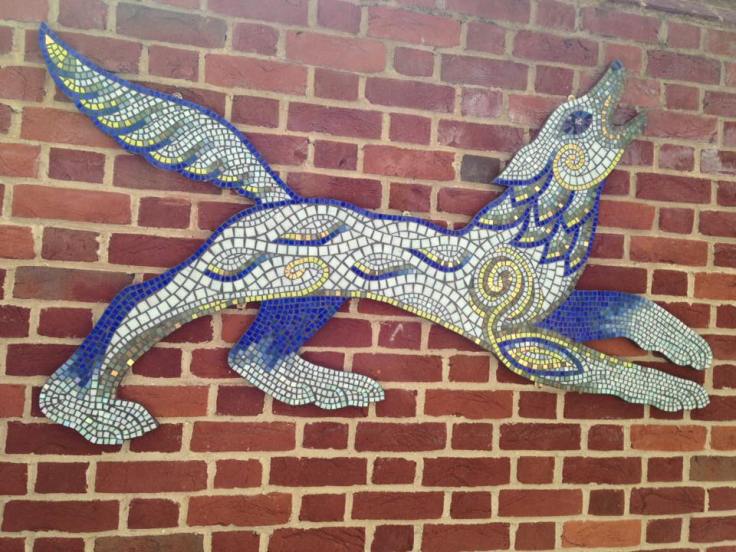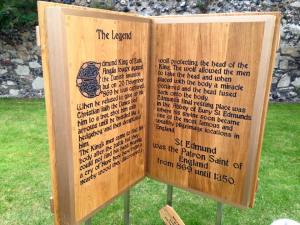 This weekend I have mostly been a-wolf-hunting… following the #BuryWolfTrail in my home town of Bury St. Edmunds. The Wolf Trail is a town trade and tourism effort to encourage visitors and support businesses in the town over the summer. I had planned to write a blog overviewing it, upload all my photos etc… but the more I thought about the more I realised I’d had such a positive emotional experience from this project because of tiny details that a review wouldn’t capture.
This weekend I have mostly been a-wolf-hunting… following the #BuryWolfTrail in my home town of Bury St. Edmunds. The Wolf Trail is a town trade and tourism effort to encourage visitors and support businesses in the town over the summer. I had planned to write a blog overviewing it, upload all my photos etc… but the more I thought about the more I realised I’d had such a positive emotional experience from this project because of tiny details that a review wouldn’t capture.
I’ve longed worked with graphics, CAD and design and have some arty leanings but I rarely work or interact with the world without a computer, network or similar involved. Really good art and architecture interacts with people and its surroundings. Often it’s not an object itself but its placement, the way it interacts with the space and other objects around it and those thoughts, memories and questions it provokes in the viewer and those sharing the space. 
I haven’t finished the wolf trail and still have wolves to find but I felt moved enough to need to put fingers to keyboard and capture what it meant to me and how it changed the way I felt about the town around me and how it changed how I observed it…. but perhaps just a wolf at a time…
The Mosaic Wolf
This isn’t typical of the wolves on the trail, the majority are 3D and this one is 2D. It’s also mounted on a wall rather than free standing. This wolf is located in the rather grandly-titled Hanchet Square, which is located behind the town’s modern “Arc” shopping centre. When I googled for a picture or link to Hanchet Square I only found this “Public toilet facilities within arc are located just off Hanchet Square, Walk in between New Look and Debenhams to access them.” That pretty much does sum up the location, Hatchett Square is a bleak little modern access area, tucked behind the shopping centre, a place delivery lorries can load, a cut through from Waitrose car-park. A barren, modern space there for functionality, not a public space or garden you’d actively seek out or rank as a favourite.
On a hot, dry August day, in brilliant sunshine with bright blue skies, the lack of shade or vegetation in this man made void emphasised this was not a place one would choose to actively seek out, in a town full of better spaces and gardens. The modern brickwork not yet much weathered by age in the few years since built was as soulless as when the developers’ contractors had left it.  The wolf hung on the one wall that offered a little shade in the midday heat, opposite the public toilets, with a hot and bother father and son (with shopping weary scowls) slunk up close to the wall waiting while mum changed the baby in the toilets.
The wolf hung on the one wall that offered a little shade in the midday heat, opposite the public toilets, with a hot and bother father and son (with shopping weary scowls) slunk up close to the wall waiting while mum changed the baby in the toilets.
Against the crisp modern orange brick and the beige stone of the rest of the square, the wolf made of tiny blue, white and gold glass tiles broke the desert. The cold, hard, permanence of the glass was solid, this could last a 1000 years, sun, wind and rain will not dull the cobalt blue. The gold glittered ethereally, like nothing from nature can, this was from the hand-of-man. The blue seemed to connect with the brilliant almost unbearably blue midday sky and pounding sun, like a vertical teleport, gold-blue-gold-gold-blue…. Both sky and the wolf almost too bright for the eye…. The dry, enclosed, closeness of the little square, both emphasised and yet broken by this strange vertical connection.
I heard a memory whisper Urban… and had a flashback to long forgotten Latin classes. I hadn’t forgotten the word Urban came from the Latin for town, I simply hadn’t remembered it. Most of the Cambridge Latin Series Textbooks rushed between my ears…. The arid, flat brickwork against the blue sky could have been in any Roman town pounded by the sun 2000 years ago, a civic space designed for functionality
- Cerberus: Caecilius est in horto. Caecilius in horto sedet. servus est in atrio. servus in atrio laborat.
Pompeii and Bury St. Edmunds merged in the midday sun and my mind. People shopping, the town planner his thoughts access and the public latrines and sanitation, so little changed. A small mosaic, man-made, emphasising the Urban, a place conquered by man, with real wolves banished to the forests. 
The #WolfTrail YouTube Video: https://www.youtube.com/watch?v=IAZNePm9_hA&feature=youtu.be
The Wolf Trail Website: http://www.ourburystedmunds.com/wolftrail

I’ve been amazed how Google Earth allows exploring areas and in some cases, in great detail. I will fly about sometimes until I find in interesting location, then “land” and walk about. It may not offer always the best imaginable resolution, but for those not able to travel so easily, it’s a great alternative. For those looking for holiday destinations, it’s a fantastic tool for checking out the views.
That all aside, I think we all need to remember that some “down time” to do other things not purely work-related, stretch both the legs and the brain, is good and gives us insight and other perspectives that can be employed in all aspects of our lives. Thanks, Rachel, for this reminder.
LikeLiked by 1 person
Thanks Tobias, I think what’s so uplifting about the wolf hunt is that so many of the places are tucked away, in parks, graveyards, ruins, inside buildings… Places the Google car can’t go… And also their very creatively placed so the experience is in being there, the weather, the sun, walking round and suddenly getting a different perspective…. Google and the Internet have made a world we can all see a picture of, but it’s a bit like the lady of shallot, watching the world in a mirror… A shallow copy of the real thing…
LikeLiked by 1 person
Not the Google car, Google Earth. The ground resolution is surprisingly good in the middle of nowhere even. Probably not enough of course to view artwork or statues, but at least to get a feel for the landscape.
I’ll email you some examples. And, yes, it’s no substitute for the real thing, but sorry, the Gulfstream is in the shop again and the Learjet is undergoing maintenance… 🙂
LikeLike
Yep, I meant Google Earth too, the zoom in data collected by the car at street level, the car with the big sticks and cameras on it…
LikeLike
Oh well, just glad you are enjoying our wolves from Arizona! I got the photos and am going to use them as changed my thoughts on the shrine wolf which would have shown up in one view you sent!
LikeLike
Really interesting piece of writing, and very enjoyable, thank you. As one of the Rojoartists who made the mosaic, I am really interested in your response to it, and your comments on its position. I wondered when you wrote about its heritage and relationship with Roman times if you had read the description on the #burywolftrail website? Also, perhaps you might like to email us at rojoart3@ yahoo.co.UK. It would be good to link up. I look forward very much to your writing on the other wolves, this is a great part1.
LikeLike
Hi Heidi,
No I’m afraid I hadn’t read anything, it was just a personal response to the wolf and its setting…. Have you got a link to the article I probably should have read?
Rachel
LikeLike
Hi Rachel, no not an article, just the blurb under ‘Rojo Artists’ on the Bury Wolf Trail page. We based the mosaic on wolves in medieval manuscripts and bestiaries so the Roman influence you felt interested me. The glass tiles are Italian! I am much happier that your wrote your piece as pure response to the work rather than having seen the blurb really.
LikeLiked by 1 person
Please note our own website is http://www.rojoart.co.uk
LikeLike
Cereberus, the dog and first chapter of cambridge Latin series was based on these mosaics https://en.m.wikipedia.org/wiki/Beware_of_the_dog
LikeLike
I spontaneously became interested in this “a-hunting” phrase you used (well-known from the old 18th century song which subsequently became the popular nursery rhyme “A-Hunting We Will Go”). The “a-” prefix is described in https://en.wikipedia.org/wiki/A-Hunting_We_Will_Go as follows: “The a- is an archaic intensifying prefix; compare Here We Come A-wassailing/Here We Come A-caroling and lyrics to The Twelve Days of Christmas (e.g., “Six geese a-laying”).” I guess it must have been an intense experience! 🙂
LikeLiked by 1 person
Didn’t even occur to me I was using archaic english 😄 yep I know the a-hunting song…. Archaic probably has different levels in BSE 😂
LikeLiked by 1 person
Hi Rachel
This is Jacquie from Twitter. I see Heidi has already responded. Its interesting working collaboratively and wondering whether we have a collective response or even, on reflection, how similar our starting points were. As Heidi mentioned we studied the bestiaries and also hunted down existing representations of the wolf legend in the town (there are only a few of them). The stylisation of the wolf’s fur in medieval times was really interesting, often the fur was represented as a feather-like motif.
Regarding the site, we see the town as still very much being of two halves and we wanted to link the old town into the new. I personally found your remarks about the wall being a forgotten space very relevant. Even though the local Arc management were very supportive the site of the artwork was impacted by shopping centre regulations. I feel the slightly compromised, not quite perfect situation is actually quite an interesting comment on how we understand public space.
Your comments about the urban wolf surprised me because our initial idea had been to create a graffiti style mosaic of a scavenging, urban wolf skulking along a wall. Maybe that subconscious thought got through to you somehow.
Looking forward to the rest of your posts
Jac
LikeLiked by 1 person